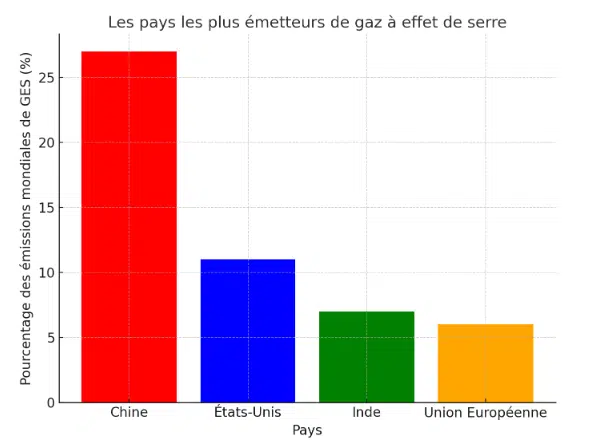
What is a country’s carbon footprint?
A country’s carbon footprint corresponds to the greenhouse gas (GHG) emissions generated by its economic and industrial activities. it includes emissions from sectors such as industry, energy, transportation, and agriculture. these GHGs, primarily composed of carbon dioxide (co2), methane (ch4), and nitrous oxide (n2o), contribute to global warming.
The carbon footprint of a country is measured in tons of co2 equivalent (tco2e), allowing for the comparison of the environmental impact of different countries. this footprint is a key indicator for understanding each country’s contribution to global emissions and for guiding strategies to reduce emissions on a global scale.
The largest greenhouse gas-emitting countries
The ranking of countries based on their total greenhouse gas emissions (GHG) is led by china, responsible for 27% of global emissions. the united states follows with 11%, then india (7%) and the european union (6%). these countries are the largest contributors to global warming due to their large populations, high levels of industrialization, and strong reliance on fossil fuels (coal, oil, gas).
China and india, in the midst of economic growth, are increasing their emissions with industrialization and urbanization. the united states, despite having a smaller population, has a high carbon footprint due to its intensive use of fossil energy. the european union, which has been reducing its emissions for several years, remains a significant player due to its historical industrial infrastructure.

Carbon footprint per capita: a key indicator
Carbon footprint per capita is a crucial indicator for evaluating individual impact on the climate. the united states and gulf countries have very high per capita footprints, due to high energy consumption, dependence on fossil fuels, and energy-intensive lifestyles (transportation, diet). conversely, countries like india and several african nations have much lower footprints, linked to lower levels of development and reduced energy consumption. thus, lifestyle, including the use of individual transportation, heating or air conditioning, and the consumption of animal products, plays a major role in carbon footprint.
Fossil fuels vs. renewable energy
Dependence on fossil fuels, such as coal, oil, and gas, is one of the main reasons for the high carbon footprint in countries like china, india, and the united states. these countries heavily rely on fossil fuels to produce electricity and power their industries, thus contributing to their high greenhouse gas emissions.
On the other hand, some countries, such as scandinavian countries (norway, sweden) and costa rica, have stood out for their successful transition to renewable energy. these countries use solar, wind, and hydropower to reduce their carbon footprints. costa rica, for instance, is a model in producing 100% renewable electricity. these successes demonstrate that the energy transition is possible and offers a long-term solution for reducing emissions.
Comparison of climate policies to reduce the carbon footprint
The paris agreement sets global greenhouse gas reduction targets to limit global warming to 1.5-2°c. each country must set national targets to achieve this goal. in europe, the european green deal aims to make the eu climate-neutral by 2050, with intermediate targets of reducing emissions by 55% by 2030. in the united states, federal initiatives like the inflation reduction act (IRA) and investments in renewable energy aim to decarbonize the economy. china has announced an ambitious plan for carbon neutrality by 2060, with emissions expected to peak before 2030.
The impact of developed vs. emerging economies
Industrialized countries, such as the united states and european nations, are historically responsible for a significant share of greenhouse gas (GHG) emissions due to their early industrialization and massive use of fossil fuels. this historical contribution plays a major role in current global warming.
In contrast, emerging economies like china, india, and brazil are experiencing rapid growth in their emissions. their economic development still heavily relies on fossil fuel exploitation. therefore, it is essential to balance economic growth with emissions reduction without compromising development. emerging countries may seek financial and technological support from industrialized nations to succeed in this transition while meeting climate commitments


